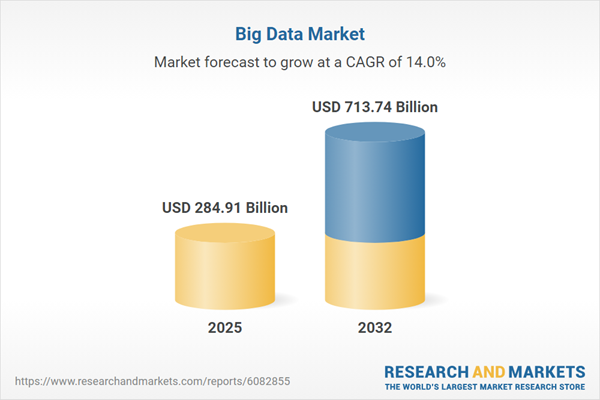Speak directly to the analyst to clarify any post sales queries you may have.
The global big data market is evolving as enterprises prioritize actionable insights, operational agility, and compliance. Organizations across industries are scaling data ecosystems, intensifying demand for advanced analytics and innovative infrastructures that support strategic decision-making.
Market Snapshot: Big Data Market Size and Growth
The big data market grows substantially, having expanded from USD 250.48 billion in 2024 to USD 284.91 billion in 2025. Projections indicate continued momentum with a CAGR of 13.98% through 2032, ultimately reaching USD 713.74 billion. This sustained trajectory reflects enterprise digital transformation, a rapidly shifting compliance landscape, and strong demand for analytics-driven solutions that underpin operational strategies across multiple sectors.
Scope & Segmentation: Unlocking Big Data’s Value Across Ecosystems
This report provides a comprehensive analysis of the market’s structure and dynamics, evaluating technologies, end-user demands, and global and regional priorities. The segmentation framework enables decision-makers to assess where organizational investments in big data yield the greatest value, emphasizing the interplay of segment relevance, technology implementation, and regional dynamics.
- Component: Hardware, managed services, professional services, business intelligence tools, data analytics platforms, data management suites, and visualization utilities all support enterprise data architecture and drive distinct value propositions.
- Data Type: Semi-structured, structured, and unstructured data architectures each require specialized integration, storage solutions, and analytical frameworks to translate diverse datasets into actionable insights.
- Deployment: Cloud-based, on-premises, and hybrid deployment models offer organizations flexibility, aligning infrastructure with specific requirements for scalability and control.
- Application: Business intelligence, data management—including governance, integration, quality, and master data management—visualization, risk analytics, and advanced analytics (descriptive, prescriptive, predictive modeling) represent high-priority enterprise use cases.
- Industry: BFSI, energy and utilities, government and defense, healthcare (diagnostics, hospitals, life sciences), IT and telecom, manufacturing, media and entertainment, retail, and e-commerce each leverage big data to enhance sector-specific processes and strategies.
- Organization Size: Large enterprises and SMEs evaluate solutions and deployment models tailored to their operational scale, resources, and strategic objectives.
- Region: Americas (notably United States, Canada, and several Latin American nations), Europe, Middle East and Africa (including UK, Germany, France, Russia, and key economies), and Asia-Pacific (China, India, Japan, Australia, South Korea, Southeast Asia) form distinct yet interconnected regional markets, each responding to unique regulatory and infrastructural challenges.
- Company Profiles: Leading market participants include Microsoft Corporation, SAP SE, Oracle Corporation, International Business Machines Corporation, SAS Institute Inc., Amazon Web Services, Google LLC, Alibaba Group, Teradata Corporation, and Cloudera, Inc.
Key Takeaways for Senior Decision-Makers
- Integration of cloud, AI, and edge computing drives the modernization of enterprise data strategies, enhancing agility and resilience within business operations.
- The confluence of structured and unstructured data significantly increases integration and governance complexity, making advanced analytics solutions and cross-functional collaboration increasingly vital.
- Modular and hybrid infrastructure ecosystems enable organizations to experiment, democratize data access, and adapt quickly to regulatory changes and evolving compliance standards.
- Regional regulatory pressures and localized data sovereignty requirements shape adoption strategies in sectors such as financial services and healthcare, influencing procurement decisions and supplier relationships.
- Strategic collaboration among technology vendors, system integrators, and industry alliances drives access to integrated solutions and contributes to sustained differentiation in competitive markets.
- Cultivating analytical expertise and fostering a data-driven organizational culture amplify returns on big data investments by informing faster, evidence-based executive decisions.
Tariff Impact: Navigating Trade and Supply Chain Adjustments
Recent tariff changes have prompted enterprises to reevaluate supply chain strategies for key big data hardware components. Organizations are strengthening vendor partnerships, considering diversified sourcing, and exploring regional manufacturing options to ensure cost stability. These adjustments affect cloud deployment strategies and encourage deeper collaboration with local data center operators. Technology providers are responding with increased service transparency and inventive support models, aligning with transformation objectives.
Methodology & Data Sources
This analysis integrates multiple primary and secondary sources, including industry publications, regulatory filings, and technology whitepapers. Executive interviews and consultations with subject-matter experts enrich quantitative findings. Rigorous data triangulation and stakeholder reviews uphold the reliability and actionability of the conclusions.
Why This Report Matters for Senior Leaders
- Enables executives to adapt big data strategies in line with evolving regulations, shifting operational demands, and ongoing technological advancement.
- Offers in-depth segmentation and risk analysis across sectors and geographies, allowing leaders to identify market opportunities and proactively mitigate risks.
- Supports confident strategic planning with specialized, evidence-based insights targeted to enterprise priorities in a dynamic data environment.
Conclusion
Big data is a foundational element of modern enterprise strategy, supporting innovation, operational efficiency, and compliance. Leaders who foster collaboration and embrace adaptive approaches are best positioned to capture ongoing value as the data ecosystem evolves.
Table of Contents
3. Executive Summary
4. Market Overview
7. Cumulative Impact of Artificial Intelligence 2025
Companies Mentioned
The companies profiled in this Big Data market report include:- Microsoft Corporation
- SAP SE
- Oracle Corporation
- International Business Machines Corporation
- SAS Institute Inc.
- Amazon Web Services, Inc.
- Google LLC
- Alibaba Group Holding Limited
- Teradata Corporation
- Cloudera, Inc.
Table Information
| Report Attribute | Details |
|---|---|
| No. of Pages | 186 |
| Published | October 2025 |
| Forecast Period | 2025 - 2032 |
| Estimated Market Value ( USD | $ 284.91 Billion |
| Forecasted Market Value ( USD | $ 713.74 Billion |
| Compound Annual Growth Rate | 13.9% |
| Regions Covered | Global |
| No. of Companies Mentioned | 11 |









